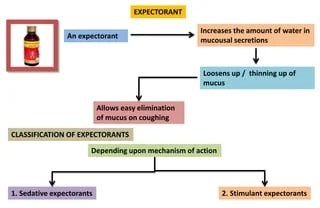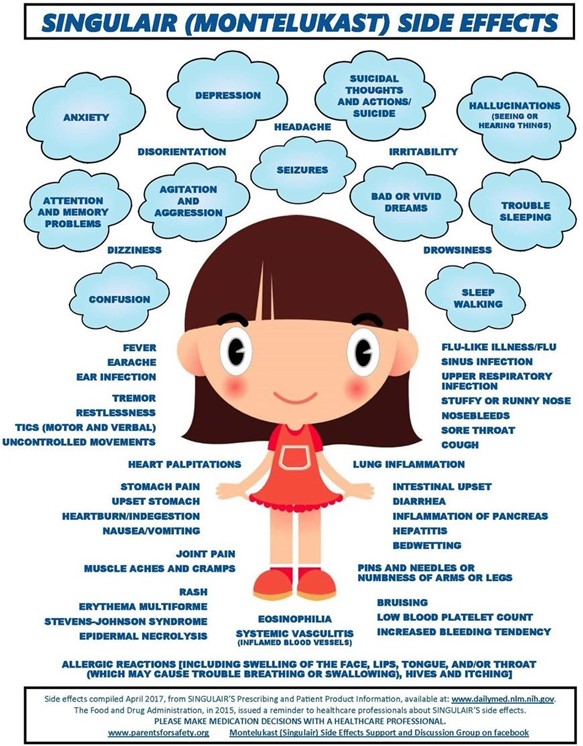A nurse is teaching a client about taking an expectorant to treat a cough. The nurse should explain that this type of medication has which of the following actions?
Reduces inflammation
Dries mucous membranes
Stimulates secretions
Suppresses the urge to cough
The Correct Answer is C
Expectorants are medications that help to loosen and thin mucus in the respiratory tract, making it easier to cough up and expel. They work by increasing the production of respiratory tract secretions, which helps to hydrate and thin the mucus, making it less sticky and easier to clear from the airways. By stimulating the production and secretion of mucus, expectorants promote coughing and facilitate the removal of excess mucus and phlegm from the respiratory system.
It's important to note that expectorants are primarily used for productive coughs (coughs that produce phlegm or mucus). If the cough is dry and non-productive, other types of cough suppressants or remedies may be more appropriate.
Regarding the other options:
Reduces inflammation: Expectorants do not have a direct effect on reducing inflammation in the respiratory tract. Anti-inflammatory medications such as glucocorticoids are typically used for reducing inflammation in conditions like asthma or chronic obstructive pulmonary disease (COPD).
Dries mucous membranes: Expectorants do not have a drying effect on mucous membranes. In fact, they work to increase the hydration and fluidity of respiratory secretions.
Suppresses the urge to cough: Expectorants do not suppress the urge to cough. They promote coughing by facilitating the clearance of mucus and phlegm from the airways. Cough suppressants, on the other hand, are medications used to relieve a dry, non-productive cough by suppressing the cough reflex.

Nursing Test Bank
Naxlex Comprehensive Predictor Exams
Related Questions
Correct Answer is D
Explanation
Leukotriene receptor antagonists (LTRAs) like Montelukast are commonly used in the treatment of asthma. They work by blocking the action of leukotrienes, which are inflammatory substances that can cause narrowing and inflammation of the airways in individuals with asthma. By preventing this inflammation, LTRAs help to reduce asthma symptoms and prevent asthma attacks.
The other options mentioned in the statements are not accurate or appropriate for teaching about Montelukast. Taking the medication only when experiencing symptoms is not the recommended approach, as LTRAs are typically taken regularly as part of ongoing asthma management. The statement about the therapeutic effect taking several weeks to notice is not accurate, as Montelukast can start to provide symptom relief within a shorter timeframe.
Additionally, the statement about increasing fiber and fluid intake to prevent constipation is unrelated to the use of Montelukast and may not apply to this medication specifically.
Correct Answer is C
Explanation
Montelukast is a medicine used to treat and prevent asthma and allergic rhinitis. It can cause some side effects, such as stomach pain, headache, cough, or fever. However, some side effects are more serious and need to be reported to the provider.
According to the sources I found, the most serious side effect of montelukast that should be reported to the provider is depression. Depression is a mental health condition that can affect your mood, thoughts, and behavior. It can cause symptoms such as feeling sad, hopeless, or worthless; losing interest in activities you used to enjoy; having trouble sleeping or concentrating; or having thoughts of harming yourself or others.
Montelukast has been linked to neuropsychiatric events, such as agitation, aggression, sleep disturbances, suicidal thoughts and behavior (including suicide). The mechanisms underlying these events are not well understood, but they can occur at any time during treatment. Therefore, patients and caregivers should be alert for changes in behavior or new neuropsychiatric symptoms when taking montelukast. If these occur, they should discontinue montelukast and contact a healthcare provider immediately.
The other options are not listed as serious side effects of montelukast that need to be reported to the provider. Constipation, blurred vision, and palpitations are possible side effects of other medicines used to treat asthma or allergic rhinitis, such as corticosteroids, antihistamines, or beta-agonists. However, they are not specific to montelukast and may not be related to its use.

Whether you are a student looking to ace your exams or a practicing nurse seeking to enhance your expertise , our nursing education contents will empower you with the confidence and competence to make a difference in the lives of patients and become a respected leader in the healthcare field.
Visit Naxlex, invest in your future and unlock endless possibilities with our unparalleled nursing education contents today
Report Wrong Answer on the Current Question
Do you disagree with the answer? If yes, what is your expected answer? Explain.
Kindly be descriptive with the issue you are facing.
